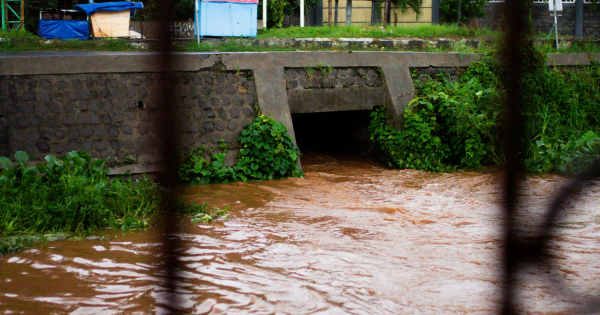Flood Alerts Explained: Understanding And Preparing For Flood Risks

Table of Contents
Flood alerts are warnings issued by meteorological and governmental agencies to inform the public about the potential or imminent threat of flooding. Their purpose is to give people sufficient time to take protective measures, minimizing the impact of flooding on life and property. This article will provide a detailed look at different types of flood alerts, reliable information sources, and actionable steps to build a robust flood preparedness plan.
Understanding Different Types of Flood Alerts and Warnings
Flood alerts are not all created equal. Different levels signify varying degrees of flood risk, requiring different responses. These levels are often categorized into stages like flood watch, flood alert, and flood warning, though specific terminology and the number of levels may vary geographically.
For example, a flood watch typically indicates that conditions are favorable for flooding, meaning there's a potential for flooding to occur. The language used might be: "Conditions are conducive to rapid rises in river levels, and flooding is possible."
A flood alert, on the other hand, suggests that flooding is imminent, or expected within the next few hours. You might see phrasing such as: "Flooding is expected, prepare for possible evacuation."
Finally, a flood warning signifies that flooding is either occurring or will occur imminently. The language will be direct: "Flooding is taking place or is expected very soon. Take immediate action to protect yourself and your property."
- Flood Watch: Potential for flooding; monitor conditions.
- Flood Alert: Flooding is imminent; prepare for action.
- Flood Warning: Flooding is occurring; take immediate action.
Geographical variations exist in alert systems. The UK's Met Office uses a different system from the US National Weather Service (NOAA). Understanding your region's specific alert system is crucial for effective preparedness. The following table summarizes common alert levels:
| Alert Level | Description | Action Required |
|---|---|---|
| Flood Watch | Potential for flooding | Monitor conditions, prepare emergency supplies |
| Flood Alert | Flooding is possible within the next few hours | Prepare for evacuation, move valuables to higher ground |
| Flood Warning | Flooding is occurring or imminent | Evacuate if instructed, seek shelter, contact emergency services |
Sources of Reliable Flood Alert Information
Staying informed is paramount. Multiple sources provide reliable flood alerts, each offering unique strengths:
- National meteorological services: Organizations like the NOAA (USA) and the Met Office (UK) provide comprehensive weather forecasts and flood warnings.
- Local government websites and emergency services: These often offer hyperlocal alerts tailored to your specific area.
- Mobile apps: Many weather and emergency alert apps (e.g., FEMA, AccuWeather) push notifications directly to your phone.
- News media and social media: While helpful for situational awareness, exercise caution to avoid misinformation. Verify information with official sources.
Registering for alerts in your area is vital. Many services allow you to specify your address, ensuring you receive timely and location-specific warnings. Using multiple sources for confirmation helps ensure you're not missing critical information.
Creating a Flood Preparedness Plan Based on Flood Alerts
A comprehensive flood preparedness plan is your best defense. Don't wait for a flood alert; develop your plan before a flood threatens. This plan should include:
- Identify flood risks: Assess your home's vulnerability to flooding – are you in a flood plain?
- Develop an evacuation plan: Plan escape routes, assembly points, and designated out-of-area contacts.
- Prepare an emergency kit: Include essentials like water, food, first-aid supplies, medications, flashlights, and blankets. A complete checklist should be readily available.
- Secure important documents and valuables: Store vital papers and irreplaceable items in waterproof containers or a safe place.
- Know how to turn off utilities: This will prevent further damage in the event of flooding.
Adjust your plan based on the severity of the flood alert. A flood watch requires less immediate action than a flood warning.
Actions to Take During Different Flood Alert Levels
Your response depends on the alert level.
Flood Watch: Monitor water levels, review your preparedness plan, and gather essential items.
Flood Alert: Move valuables to higher ground, prepare your vehicle for potential evacuation, and continue monitoring the situation.
Flood Warning: Evacuate if instructed, seek shelter if necessary, contact emergency services, and follow instructions from authorities. Remember, your safety is the top priority. Do not attempt to drive through floodwaters.
Post-Flood Actions and Recovery
After the flood, prioritize safety and recovery:
- Check for structural damage: Avoid entering damaged buildings until declared safe by authorities.
- Contact insurance companies: Report damages promptly to initiate the claims process.
- Avoid contaminated water: Floodwaters often contain harmful substances. Use protective gear when cleaning up.
- Clean and disinfect affected areas: Thoroughly clean and disinfect everything that came into contact with floodwater.
- Seek assistance from relevant authorities: Local government and emergency services offer support to flood victims.
Flooding can have a significant psychological impact. Reach out for mental health support if needed. Many organizations provide resources and counseling services to help people cope with the aftermath of a flood.
Staying Safe with Flood Alerts
Understanding and responding to flood alerts is crucial for mitigating the risks associated with flooding. Having a comprehensive flood preparedness plan in place, knowing where to find reliable flood alert information, and understanding the actions required for different alert levels will save lives and minimize property damage. Actively seek out reliable sources of flood alert information, and register for alerts in your area. Don't wait for a crisis – prepare today! Stay informed and prepared – learn more about flood alerts and create your flood preparedness plan today!

Featured Posts
-
 La Guerre Contre L Iptv Comprendre La Strategie De Rtbf Et Rtl Belgium
May 26, 2025
La Guerre Contre L Iptv Comprendre La Strategie De Rtbf Et Rtl Belgium
May 26, 2025 -
 Canada Posts Struggles Fueling The Rise Of Alternative Delivery Services
May 26, 2025
Canada Posts Struggles Fueling The Rise Of Alternative Delivery Services
May 26, 2025 -
 Decouvrir Melanie Thierry Roles Emblematiques Et Vie Privee
May 26, 2025
Decouvrir Melanie Thierry Roles Emblematiques Et Vie Privee
May 26, 2025 -
 Kembalinya Moto Gp Ke Brasil Sirkuit Ayrton Senna Di Goiania Menjadi Tuan Rumah
May 26, 2025
Kembalinya Moto Gp Ke Brasil Sirkuit Ayrton Senna Di Goiania Menjadi Tuan Rumah
May 26, 2025 -
 Palais Des Congres De Liege Le Devenir Des Locaux Rtbf
May 26, 2025
Palais Des Congres De Liege Le Devenir Des Locaux Rtbf
May 26, 2025
Latest Posts
-
 Nba Lifts Ban John Haliburton Returns To Pacers Games
May 28, 2025
Nba Lifts Ban John Haliburton Returns To Pacers Games
May 28, 2025 -
 Tyrese Haliburtons Father Back At Pacers Games Following Nba Ban
May 28, 2025
Tyrese Haliburtons Father Back At Pacers Games Following Nba Ban
May 28, 2025 -
 John Haliburtons Dad Returns To Pacers Games After Nba Ban
May 28, 2025
John Haliburtons Dad Returns To Pacers Games After Nba Ban
May 28, 2025 -
 Samsung Galaxy S25 Ultra Avis Et Prix
May 28, 2025
Samsung Galaxy S25 Ultra Avis Et Prix
May 28, 2025 -
 Ou Acheter Le Samsung Galaxy S25 Ultra Moins Cher
May 28, 2025
Ou Acheter Le Samsung Galaxy S25 Ultra Moins Cher
May 28, 2025
